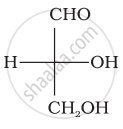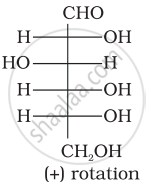Advertisements
Advertisements
प्रश्न
Write a classification of proteins with an example.
उत्तर
- Globular Proteins: Molecules of globular proteins have spherical shape. This shape results from coiling around of the polypeptide chain of protein. Globular proteins are usually soluble in water.
For example: insulin, egg albumin, serum albumin, legumelin (protein in pulses) -
Fibrous Proteins: Molecules of fibrous proteins have an elongated, rod-like shape. This shape is the result of holding the polypeptide chains of protein parallel to each other. Hydrogen bonds and disulfide bonds are responsible for this shape. Fibrous proteins are insoluble. in water.
For example: keratin (present in hair, nails, and wool); myosin (protein of muscles).
APPEARS IN
संबंधित प्रश्न
How are proteins classified on the basis of molecular shapes?
What is peptide linkage?
What type of bonding helps in stabilising the ∝-helix structure of proteins?
Differentiate between the following :
Fibrous proteins and Globular proteins
Which of the following biomolecules is insoluble in water?
The protein responsible for blood clotting is ____________.
Which functional group participates in disulphide bond formation in proteins?
Which of the following statement is correct:
Dinucleotide is obtained by joining two nucleotides together by phosphodiester linkage. Between which carbon atoms of pentose sugars of nucleotides are these linkages present?
Optical rotations of some compounds along with their structures are given below which of them have D configuration.
| (I) |  |
| (II) |  |
| (III) |  |
Proteins can be classified into two types on the basis of their molecular shape i.e., fibrous proteins and globular proteins. Examples of globular proteins are:
(i) Insulin
(ii) Keratin
(iii) Albumin
(iv) Myosin
In fibrous proteins, polypeptide chains are held together by:
(i) van der Waals forces
(ii) disulphide linkage
(iii) electrostatic forces of attraction
(iv) hydrogen bonds
Which of the following are purine bases?
(i) Guanine
(ii) Adenine
(iii) Thymine
(iv) Uracil
Structures of glycine and alanine are given below. Show the peptide linkage in glycylalanine.
\[\ce{\underset{(Glycine)}{H2N - CH2 - COOH}}\];
\[\begin{array}{cc}
\ce{H2N - CH2 - COOH}\\
|\phantom{......}\\
\ce{\underset{(Alanine)}{CH3}\phantom{...}}
\end{array}\]
Protein found in a biological system with a unique three-dimensional structure and biological activity is called a native protein. When a protein in its native form, is subjected to a physical change like change in temperature or a chemical change like, change in pH, denaturation of protein takes place. Explain the cause.
Assertion: β-glycosidic linkage is present in maltose,

Reason: Maltose is composed of two glucose units in which C–1 of one glucose unit is linked to C–4 of another glucose unit.
Explain the terms primary and secondary structure of proteins. What is the difference between α-helix and β-pleated sheet structure of proteins?
The main structural feature of proteins is
Each polypeptide in a protein has amino acids linked with each other in a specific sequence. This sequence of amino acids is said to be ______.
Explain formation of peptide linkage in protein with an example.
Given below are two statements labelled as Assertion (A) and Reason (R).
Assertion (A): Proteins are found to have two different types of secondary structures viz alpha-helix and beta-pleated sheet structure.
Reason (R): The secondary structure of proteins is stabilized by hydrogen bonding.
Select the most appropriate answer from the options given below:
An α-helix is a structural feature of ______.
Proteins are polymers of ______.
Assertion (A): Proteins are polymers of α-amino acids connected by a peptide bond.
Reason (R): A tetrapeptide contains 4 amino acids linked by 4 peptide bonds.
